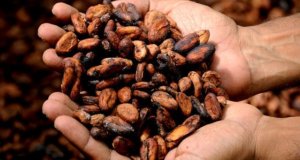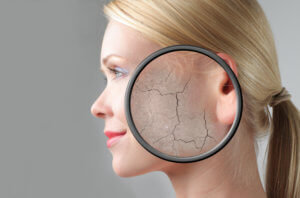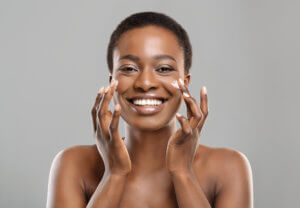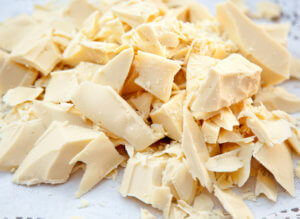Cocoa butter is an amazing substance. Not only is it edible and used to make chocolate, it’s also a superstar skincare ingredient, particularly if you have dry or damaged skin.
Basically, cocoa butter is a rich and nourishing fat. It’s most comparable to coconut oil or shea butter, although it has its own unique properties. You can use it as a standalone skin treatment if your skin is really in need of serious repair, or make use of it in a skincare product— ideally with other plant-based ingredients.
Here’s more about what makes cocoa butter so outstanding for skin and how to make the most of it.
What is Cocoa Butter? + The Unique History of a Famous Bean
Cocoa butter is derived from cocoa beans that grow on cacao trees. Technically, these so-called cocoa “beans” are actually the seeds of the plant. They form by the dozens inside large pods when the trees get at least 5 years old.
Cacao trees are native to regions in Central and South America. The botanical name for the trees (Theobroma cacao) literally translates to “food of the gods,” so it’s clear that cocoa has been loved for thousands of years!
In fact, historians believe that cocoa beans have been prized and utilized since at least 460 AD. They were highly valuable to the ancient Aztec and Mayan civilizations, even being used as a form of currency at one point. Cacao also played a big role in spiritual ceremonies and was served at royal feasts.
Cocoa beans first began to spread to the rest of the world by the unfortunate route of Spanish invaders.
Thanks to the invention of chocolate in the 19th century, they have become one of the most popular foods in the world and show no signs of slowing down.
How Cocoa Butter is Made

What we call cocoa butter is simply the fatty portion of cocoa beans. To extract it, the beans are typically fermented, roasted, and pressed. This process separates the fat from the solid part of the bean, which can then be ground down to make cocoa powder or nibs.
Cocoa fat is typically pale or creamy yellow with a delicious chocolatey fragrance. It’s completely solid at room temperature, but will start to melt slightly on contact with your skin.
One of the great things about pure cocoa butter is that it has a very long shelf life: 2-5 years. It adds a silky, creamy texture to skincare products like lotions and creams, making them feel rich and luxurious.
Of course, cocoa butter is also one of the stars in chocolate where it’s typically combined with cocoa powder, sugar, and milk.
Top Benefits of Cocoa Butter
Rich in Nourishing Fatty Acids
The main reason cocoa butter is extremely beneficial for dry skin is because it contains several different fatty acids.
Fatty acids are a key part of your skin’s natural barrier. This barrier is especially important for keeping moisture in your skin and toxins out. Without a healthy lipid layer, which includes fatty acids, water will simply evaporate, leaving your skin dry and flaky.
The main fatty acids in cocoa butter are stearic acid, oleic acid, and palmitic acid. There is also a smaller amount of linoleic acid.
What all this translates to is rich nourishment for your skin. These fatty acids help to boost skin hydration and provide a natural barrier or seal to lock moisture in.
If your skin is seriously distressed, you can apply cocoa butter on its own to dry spots. Putting it on slightly damp skin (like after a shower) will help even more to keep moisture in your skin.
Smooths Out Skin

Dry skin is irritating enough on its own, but it can also make your complexion look flaky and uneven. Cocoa butter helps to address this by filling in gaps between skin cells with fatty acids. This can decrease flakiness and help your skin to look smooth and even.
Cocoa butter also has the potential to smooth out marks on your skin like scars and stretch marks. Studies have yet to confirm this benefit, but anecdotal “evidence” is strongly in favor of it.
The bottom line is that applying cocoa butter to scars, stretch marks, etc. won’t hurt anything and might help. Apply it daily as is or in a cream to help smooth out skin marks.
Full of Antioxidants with Anti-Aging Power
To go along with the nourishing fatty acids, cocoa butter also contains antioxidants that help combat signs of aging.
The main type of antioxidants in cocoa are known as “cocoa mass polyphenols”. Some studies have indicated that they have massive anti-aging potential, particularly by boosting collagen, improving elasticity, and evening out skin tone.
All of this helps your skin to look younger and may diminish the appearance of wrinkles, fine lines, age spots, etc.
In fact, polyphenols in general may be some of the best antioxidants for younger-looking skin. Research has shown that they promote cellular regeneration and skin cell repair, combating skin aging at the deepest level. They also have an anti-inflammatory effect that helps to brighten your complexion.
And by supporting the production of collagen— a very important skin protein— polyphenols may help prevent wrinkles and other signs of aging from appearing.
Helps Protect Skin from Damage

Cocoa butter helps protect your skin in two ways: by supporting your skin barrier and through antioxidant power.
As briefly mentioned earlier, your skin’s natural barrier isn’t just there to keep moisture from escaping. It also has the job of keeping toxins and potentially harmful substances from getting in. The fatty acids in cocoa butter help to strengthen this “shield” and prevent damage from wind, heat, toxins, etc.
The antioxidants in cocoa also have protective properties at an even deeper level.
If you’ve ever heard of free radicals, you know they can cause damage to other cells. This applies to skin cells as well as other cells within your body, leading to skin aging that starts at the cellular level. By applying and/or consuming antioxidants— like polyphenols— you help protect your skin from the effects of free radicals.
In addition to this, research has shown that polyphenols also help protect against photodamage.
Photodamage refers to signs of aging (wrinkles, dark spots, rough skin, etc.) that appear due to UV damage from the sun. This type of damage is particularly difficult to reverse, but antioxidants contribute to preventing it.
For an even greater effect, combine cocoa butter with other antioxidant ingredients like astaxanthin or resveratrol.
Soothing for Sensitive Skin
Everyone’s skin reacts to skincare ingredients differently. However, in general, cocoa butter is extremely soothing for sensitive or irritated skin. It deeply nourishes and also has a mild anti-inflammatory effect from the presence of antioxidants.
Some people have even found that cocoa butter can help with skin issues like eczema or dermatitis. Again, clinical evidence is still lacking to confirm this benefit, but it’s certainly worth a try. Use a little bit of the butter on its own or look for it in a cream with other natural ingredients.
Smells Wonderful

This is more of a benefit for your nose than your skin, but it’s still worth mentioning. In its natural, raw state (more on that in a minute), cocoa butter has a rich chocolate-like smell.
For most people, this is a big plus and an extra reason to use cocoa butter. Melting a little of it in a warm bath or on your wrists can give you an almost aromatherapy-like experience. It can also be used to add a natural scent to skincare products.
If you are not a chocolate lover, you can always opt for a more neutral butter like mango seed butter.
Are There Any Drawbacks to Cocoa Butter?
Perhaps the biggest “downside” to cocoa butter is that it is a heavy oil and has the potential to be pore-clogging. If you are dealing with acne or have breakout-prone skin, pure cocoa butter may not be the best choice.
That being said, you may still be able to enjoy the benefits of cocoa butter in a skincare product. If you find one formulated with other ingredients, like aloe vera and lightweight oils, there’s much less of a chance that it will clog your pores.
Choosing the Best Cocoa Butter
Not all cocoa butters are on equal footing. Like any other natural ingredient, how the cocoa is grown, harvested, and processed has a big impact on how pure and beneficial the end product is.
When choosing a butter, the most important thing to look for is one that’s raw or unrefined. This means that the fat has been extracted using minimal heat, leaving the cocoa butter as close to its original form as possible. You may see this type labeled as “cacao butter” or simply raw, pure, or unrefined cocoa butter.
You can also do a quick check of your cocoa butter by looking at it and smelling it. It should have a yellowish color (white butters have been bleached) and a definite chocolatey fragrance.
A second important consideration is buying USDA Organic cocoa butter (or the equivalent in other countries). This ensures that the cocoa was grown without pesticides or chemical fertilizers and is free of common toxins.
Anti-Aging Skincare with Cocoa Butter 
If you want to use cocoa butter in your skincare routine, look into the Age-Defying Dream Cream from Purity Woods. It contains pure, organic cacao butter as one of its top moisturizing ingredients, plus powerful antioxidant and collagen-boosting botanicals.
The richness of cocoa deeply nourishes your skin, while ingredients like maple leaf extract and astaxanthin quickly work to erase signs of aging like wrinkles, fine lines, dark spots, etc. The cream is suitable for all skin types and is USDA Certified Organic, which means NO toxins, artificial ingredients, or fillers.
Learn more about the Age-Defying Dream Cream here, and enjoy the luxury of cocoa butter for your skin.


